As great as the metro system in Mexico City was, it has one major flaw - I
couldn't bring my bike along. The same was true for the buses. Long haul
buses always had large storage areas below, but the intra-city and local buses
didn't. This created a bit of a dilemma. I had already decided to start in
Toluca, a town to the west of Mexico City, so that I could avoid the suburbs of
the city and so I could visit some interesting ruins nearby. There was a long
haul bus that went there, but first I had to get to the bus station. Once
again, lacking a decent map, I was forced to use the freeways to avoid getting
totally lost. With all the rapid acceleration in order to merge, the ride to
Toluca turned out to be the most strenuous all day.
Once in the Toluca bus station, I packed up my bike and headed to downtown
to check it out. A few blocks down the road I stopped - I was pretty burnt out
on hanging out in cities, and I was burnt out on ruins. So I gave both a miss
and decided to hit the road and get some mileage under my belt.
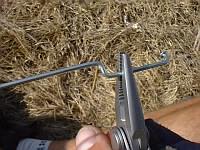 About 15 minutes into my journey, I was greeted by my first mechanical failure
- a broken spoke. Not just any spoke, mind you, but a broken spoke on the
freewheel side of the wheel. What this means in non-bike terms is that it
was time for some creative use of brute force. Officially, you need to
remove the freewheel (rear gears) to replace such spokes, but having failed
to do so successfully even with the right tool, I knew it was time for the
pliers. What you need to do is take an extra long spoke and cut the end off,
then bend a "Z" in the new end. Then you carefully thread it through the hub
and voila! instant spoke.
About 15 minutes into my journey, I was greeted by my first mechanical failure
- a broken spoke. Not just any spoke, mind you, but a broken spoke on the
freewheel side of the wheel. What this means in non-bike terms is that it
was time for some creative use of brute force. Officially, you need to
remove the freewheel (rear gears) to replace such spokes, but having failed
to do so successfully even with the right tool, I knew it was time for the
pliers. What you need to do is take an extra long spoke and cut the end off,
then bend a "Z" in the new end. Then you carefully thread it through the hub
and voila! instant spoke.
Before I knew it I was back on the road making good progress. The road was
a two lane highway, with about 6 inches of shoulder. I would ride about a
foot from the edge of the pavement (which at times had a drop-off into gravel
and dirt) and let everyone go around me. I am pretty convinced that this is
actually safer than riding on roads in the states, since in countries like
Mexico, drivers are used to having to avoid bikes, missing pavement, cows,
farmers carrying huge piles of sticks, ice cream vendors, you name it. And as
I mentioned before, being a touring bike is an advantage, because of sheer
size.
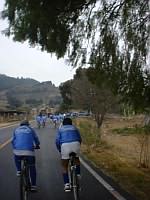 At one point, I noticed a "Caution: bicyclists on road" sign at the side of the
road. They didn't have to go to all that trouble just for me. Well, they
didn't. It turns out that there was a group of about 100 youths riding along
the road. I stopped and asked a group of them where they were going, and they
replied "Chalma." As it turns out, Chalma is a big pilgrimmage spot, and they
were on an overnight trip to ride there. These kids were quite a sight - all
wearing matching blue shirts, riding a selection of manky, rusty old bikes.
There were a few top notch bikes in the lot, but many of them were barely
holding together. It was great for the next 10km or so, since I had escort
vehicles and flagmen to clear the road for me. Unfortunately, they were going
rather slow, and pretty soon I found myself on my own again.
At one point, I noticed a "Caution: bicyclists on road" sign at the side of the
road. They didn't have to go to all that trouble just for me. Well, they
didn't. It turns out that there was a group of about 100 youths riding along
the road. I stopped and asked a group of them where they were going, and they
replied "Chalma." As it turns out, Chalma is a big pilgrimmage spot, and they
were on an overnight trip to ride there. These kids were quite a sight - all
wearing matching blue shirts, riding a selection of manky, rusty old bikes.
There were a few top notch bikes in the lot, but many of them were barely
holding together. It was great for the next 10km or so, since I had escort
vehicles and flagmen to clear the road for me. Unfortunately, they were going
rather slow, and pretty soon I found myself on my own again.
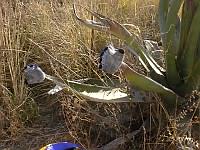 As darkness fell, I had to start thinking of where to sleep. I decided to camp
beside the road, if for no other reason than to justify lugging all that
camping gear around. I found a beautiful spot, overlooking vast rolling hills,
with a gorgeous 15 foot tall cactus right in camp. Unfortunately, the only flat
spot around that wasn't on the edge of a crumbling cliff was under the lower
leaves of the cactus. Now this cactus had some serious spikes on it - 2 inches
long, 1/4 inch in diameter, and hard as steel. Realizing that it would be
fatal to accidentally stab myself with one in the middle of the night, I
disarmed it by putting used film canisters on the nearby spikes. I put my
leather cycling gloves over the canisters since the spikes wouldn't have too
hard a time penetrating through the first level of defense.
As darkness fell, I had to start thinking of where to sleep. I decided to camp
beside the road, if for no other reason than to justify lugging all that
camping gear around. I found a beautiful spot, overlooking vast rolling hills,
with a gorgeous 15 foot tall cactus right in camp. Unfortunately, the only flat
spot around that wasn't on the edge of a crumbling cliff was under the lower
leaves of the cactus. Now this cactus had some serious spikes on it - 2 inches
long, 1/4 inch in diameter, and hard as steel. Realizing that it would be
fatal to accidentally stab myself with one in the middle of the night, I
disarmed it by putting used film canisters on the nearby spikes. I put my
leather cycling gloves over the canisters since the spikes wouldn't have too
hard a time penetrating through the first level of defense.
For dinner I had canned tuna, an avocado, and a prickly pear leaf, which I
had bought in the previous town. Now anyone who knows me knows how much I
despise canned tuna, but having opted against bringing a stove for weight
reasons, my only options were canned tuna or canned chilis. I opted for the
former. The prickly pear was an experiment. I thought it would add a unique
local flair, but after sticking myself on the spikes numberous times after
trying to shave off the outer skin, all I was left with was a tasteless, paper
thin sheet of flesh. Next time I'll opt for the donuts. I went to sleep
cosily wrapped up in my sleeping bag and bivy sack, watching the stars.
I started the next morning, as I had the last, by drinking potassium,
reconstituted soya, and algae powder. Sure, it sounds disgusting, but I had
bought the stuff and I wasn't about to lug it all the way to South America.
Anyway, it really didn't taste that bad. It certainly made for a better biking
breakfast than carne asada tacos.
I was making my way to a town called Malinalco, where there was a nearby
ruin, my tolerance for ruins refreshed after a good night's sleep. En route, I
passed another group of pilgrims, also bound for Chalma. This group, several
hundred in number, was walking to Chalma. This Chalma place I had to see
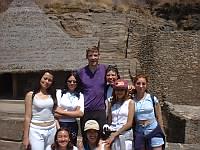 Once in Malinalco, I headed off for the ruins. They were nestled on a hilltop
overlooking the town. To get there involved walking up a stone path, which was
impossible by bike, but a local generously let me store my bike in his garage
while I was gone. The site was swarming with school kids. They immediately
became more interested in me than in the ruins. For reasons beyond my
comprehension, all the girls in the group (probably mid-teens) wanted to have
their picture taken with me. I felt like a member of Hansen.
Once in Malinalco, I headed off for the ruins. They were nestled on a hilltop
overlooking the town. To get there involved walking up a stone path, which was
impossible by bike, but a local generously let me store my bike in his garage
while I was gone. The site was swarming with school kids. They immediately
became more interested in me than in the ruins. For reasons beyond my
comprehension, all the girls in the group (probably mid-teens) wanted to have
their picture taken with me. I felt like a member of Hansen.
Back on the road, I decided to head to Chalma to see what all the excitement
was about. It was out of the way, but only by a few km. But what kilometers
they were! 4km of grueling uphill in baking heat, followed by .5km of near 15%
grade climbing. I bonked (ran out of steam) on the way up, and had to stop
every 100m or so. I should have gotten a clue when I saw all the biking
pilgrims call it quits at the bottom of the hill. Once on top, I was rewarded
by lovely Chalma - a dirty, nasty place with garbage piled everywhere and
little old ladies selling nipple-shaped ceramic mugs. I'd been robbed!
I turned around and headed towards Cuernavaca, my destination for the day.
I asked directions every km or so just to be sure, but by the time night fell,
I was totally lost. It turns out I should have kept going past Chalma instead
of turning around. I was very close to throwing out my guidebook (note to
travelers - Footprint guidebooks suck big time. I knew I should have stuck
with Lonely Planet.) By this point, I was about 50km off route to the east. I
cut my losses, found a hotel, and crashed.
The next morning I worked out a new route, going on back roads towards a
town called Izúcar de Matamoros. I once again drank my soya and algae
concoctions, but not having a glass to use, I drank out of a hollowed out gourd
I had bought in Chalma. It looked as absurd as it sounds. By noon I had hit
50k, and I stopped at a small shop, looking for lunch. It turned out to be just
a store and not a restaurant, but after chatting with the owner for a while, he
and his wife invited me to join them for lunch. A home cooked meal was a real
treat after tuna from a can, and they wouldn't even let me pay for it.
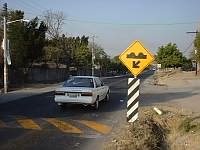 The afternoon was hot, and the terrain hilly. My progress slowed to a crawl.
Then I heard the familiar sound of a broken spoke - it seemed that my custom
bent spoke was the weak link, and it broke going over a speed bump. Now the
speed bumps in Mexico, they call them "topes," are like nothing I've
experienced before. These behemoths remind me more of something you would find
on a miniature golf course than on the road. I kept looking for the cup at the
apex. Not only were they huge, but they were strategically placed at the
bottom of long downhills, requiring me to squander all of my hard earned
momentum to avoid having a pannier yard sale. I must have lost 1/2 hour a day
from all the stupid topes. Fried from the heat and hills, I didn't make it to
Matamoros, so I once again camped by the side of the road. By that point, even
tuna was starting to sound good.
The afternoon was hot, and the terrain hilly. My progress slowed to a crawl.
Then I heard the familiar sound of a broken spoke - it seemed that my custom
bent spoke was the weak link, and it broke going over a speed bump. Now the
speed bumps in Mexico, they call them "topes," are like nothing I've
experienced before. These behemoths remind me more of something you would find
on a miniature golf course than on the road. I kept looking for the cup at the
apex. Not only were they huge, but they were strategically placed at the
bottom of long downhills, requiring me to squander all of my hard earned
momentum to avoid having a pannier yard sale. I must have lost 1/2 hour a day
from all the stupid topes. Fried from the heat and hills, I didn't make it to
Matamoros, so I once again camped by the side of the road. By that point, even
tuna was starting to sound good.
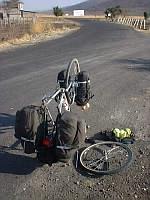 I started the next morning with what had become my daily ritual - fixing a
broken spoke. At this point I could replace a spoke in under five minutes. I
climbed most of the morning, and by lunchtime I found myself in Izúcar de
Matamoros, which they simply call Matamoros. I have yet to determine the
pattern of when to use just the first name of a city (i.e. Tepalcingo de
Hidalgo) and when to use the second. The town was like most every Mexican
town. A couple of main cathedrals with plazas in front, and a main street
filled with taquerias, pharmacies, grocery stores, and various other shops. I
also managed to locate an ATM to cure my ailing financial situation. Getting
money in Mexico is easy, as most larger towns have ATMs. I never needed to use
traveler's checks or credit cards.
I started the next morning with what had become my daily ritual - fixing a
broken spoke. At this point I could replace a spoke in under five minutes. I
climbed most of the morning, and by lunchtime I found myself in Izúcar de
Matamoros, which they simply call Matamoros. I have yet to determine the
pattern of when to use just the first name of a city (i.e. Tepalcingo de
Hidalgo) and when to use the second. The town was like most every Mexican
town. A couple of main cathedrals with plazas in front, and a main street
filled with taquerias, pharmacies, grocery stores, and various other shops. I
also managed to locate an ATM to cure my ailing financial situation. Getting
money in Mexico is easy, as most larger towns have ATMs. I never needed to use
traveler's checks or credit cards.
The afternoon involved lots of descending, which was perfectly fine by me.
When riding, I would stop about every hour for water and a snack. At one such
stop, I was greeted by the shop owner at the door. After making my purchases,
the owner returned to the table he had been sitting at with two other men. He
invited
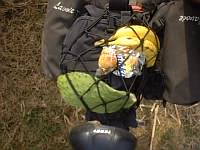 me over, and we started talking. The owner was very fond of the US, having
worked there in the 60's, with sons living in MY. Having sons in the US
enabled him to buy a new truck. It was a pretty common story; travel to the
US for 1, 2, or 5 years to earn money for their families, then return and use
the earnings to help them get by in Mexico. The man didn't have a lot of good
things to say about the Mexican government - a country with so many natural
resources should be able to prosper, but with all the corruption, people are
forced to turn to the US for fair wages. Sitting at the table was the owner's
nephew, a scrawny man of about 30, who had obviously had a few beers too many.
He would mumble something completely incomprehensible in English, then look me
in the eyes for a response. He didn't recognize my "I can't understand your
poor, drunken English" look, and he would continue staring until I replied,
"Si." He would then laugh, gesture to his uncle that he was somehow right,
then extend his hand to me. After shaking it, he would ask another question.
After indicating that his English left something to be desired, he switched to
Spanish, which with his slurring and my limited vocabulary, wasn't much better.
I eventually had to get out of there out of fear that I might get stuck talking
to this drunkard all night. I rode for another couple of hours, and ended up in
a town called Tehutzingo. The hotel there cost me 40 ps.
me over, and we started talking. The owner was very fond of the US, having
worked there in the 60's, with sons living in MY. Having sons in the US
enabled him to buy a new truck. It was a pretty common story; travel to the
US for 1, 2, or 5 years to earn money for their families, then return and use
the earnings to help them get by in Mexico. The man didn't have a lot of good
things to say about the Mexican government - a country with so many natural
resources should be able to prosper, but with all the corruption, people are
forced to turn to the US for fair wages. Sitting at the table was the owner's
nephew, a scrawny man of about 30, who had obviously had a few beers too many.
He would mumble something completely incomprehensible in English, then look me
in the eyes for a response. He didn't recognize my "I can't understand your
poor, drunken English" look, and he would continue staring until I replied,
"Si." He would then laugh, gesture to his uncle that he was somehow right,
then extend his hand to me. After shaking it, he would ask another question.
After indicating that his English left something to be desired, he switched to
Spanish, which with his slurring and my limited vocabulary, wasn't much better.
I eventually had to get out of there out of fear that I might get stuck talking
to this drunkard all night. I rode for another couple of hours, and ended up in
a town called Tehutzingo. The hotel there cost me 40 ps.
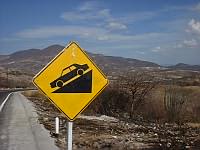 My mechanical failure for the next day was a slow leaking front tire. I
decided to just pump the tire and wait until I had a sink to look for the
puncture. As was the norm, I had a morning of climbing and descent, and after
45k, I arrived in a town called Acatlán for lunch. In the region between
Mexico and Oaxaca, a very common food is a gordito, a thick blue corn tortilla
wrapped around cheese, meat, or various other fillings. I found a great vendor
and started chowing. The woman next to her was selling fresh squeezed orange
juice for only 4 ps for a huge glass. Not one to usually use a straw, this
time I was thankful to have one. I quickly learned that the tiny maggots all
floated on the surface, and having a straw allowed me to drink from the bottom
up. Hopefully no one got offended by my tossing them, but I already had
enough protein in my diet.
My mechanical failure for the next day was a slow leaking front tire. I
decided to just pump the tire and wait until I had a sink to look for the
puncture. As was the norm, I had a morning of climbing and descent, and after
45k, I arrived in a town called Acatlán for lunch. In the region between
Mexico and Oaxaca, a very common food is a gordito, a thick blue corn tortilla
wrapped around cheese, meat, or various other fillings. I found a great vendor
and started chowing. The woman next to her was selling fresh squeezed orange
juice for only 4 ps for a huge glass. Not one to usually use a straw, this
time I was thankful to have one. I quickly learned that the tiny maggots all
floated on the surface, and having a straw allowed me to drink from the bottom
up. Hopefully no one got offended by my tossing them, but I already had
enough protein in my diet.
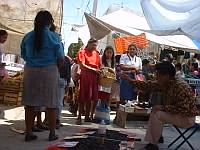 Each day I tried to hit 100km, and that day I was running behind. As I hit
90k, it was starting to get dark, and there were no hotels in sight. The next
big town, Huajuacan, was still 30k away. I was prepared to pull over to the
side of the road and camp. The sky was darkening with ominous clouds, so I
expected to put my waterproof bags and bivy sack to the test. Unfortunately, I
forgot to bring my lightning rod. An impressive lightning storm was fast
approaching, and it was getting close. With each bolt I would start counting
until I heard the thunder; the general rule is 1000 ft/s. Once they were two
seconds away, I started to get worried. I was trying to find lowlands where I
could wait it out, but the road was hugging the top of the mountain. Around
each turn I was expecting a huge descent, only to find more hills. By this
point it was completely dark, but the lightning was doing a good job of
lighting the road ahead so I could look for potholes. Then the rain hit. I
was wondering why it hadn't started raining yet, but when it hit, it came down
in buckets. It was time to get the hell out of there. There was a pickup
pulled over to the side of the road, and I went to the driver and asked, "Can
you please take me to the next town. I don't want to die out here." He
agreed, and I threw my bike in the back, on top of about 1/2 cord of wood.
There I was riding in the back of the pickup, sitting on a bunch of logs, being
pelted by rain. After a few minutes, they volunteered space up front for me.
I squeezed in - we now had four people in the cab of a mini-pickup.
Each day I tried to hit 100km, and that day I was running behind. As I hit
90k, it was starting to get dark, and there were no hotels in sight. The next
big town, Huajuacan, was still 30k away. I was prepared to pull over to the
side of the road and camp. The sky was darkening with ominous clouds, so I
expected to put my waterproof bags and bivy sack to the test. Unfortunately, I
forgot to bring my lightning rod. An impressive lightning storm was fast
approaching, and it was getting close. With each bolt I would start counting
until I heard the thunder; the general rule is 1000 ft/s. Once they were two
seconds away, I started to get worried. I was trying to find lowlands where I
could wait it out, but the road was hugging the top of the mountain. Around
each turn I was expecting a huge descent, only to find more hills. By this
point it was completely dark, but the lightning was doing a good job of
lighting the road ahead so I could look for potholes. Then the rain hit. I
was wondering why it hadn't started raining yet, but when it hit, it came down
in buckets. It was time to get the hell out of there. There was a pickup
pulled over to the side of the road, and I went to the driver and asked, "Can
you please take me to the next town. I don't want to die out here." He
agreed, and I threw my bike in the back, on top of about 1/2 cord of wood.
There I was riding in the back of the pickup, sitting on a bunch of logs, being
pelted by rain. After a few minutes, they volunteered space up front for me.
I squeezed in - we now had four people in the cab of a mini-pickup.
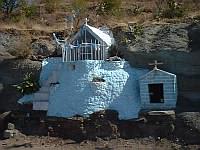 The truck, already overloaded from wood, was limping along. We traveled at
about 15 k/h, with one of the passengers continuously wiping the steam from the
driver's window. The bolts of lightning were still close, and I had a good
chance to look at them. Lightning is quite amazing up close - after the
initial flash, you can see swirls of deionized air spread out from where the
bolt was. The rain was getting heavier, and I was wondering if we were going
to get washed off the road. Pieces were literally falling off of the truck,
but apparently nothing critical. It seemed like an eternity, but we finally
pulled into Huajuacan. The lightning had stopped, and the rain had backed off.
I found the first hotel I could find with hot water, and immediately took a long
shower. Then I treated myself to a really nice dinner; enchilladas de mole and
fresh squeezed, maggot-free orange juice.
The truck, already overloaded from wood, was limping along. We traveled at
about 15 k/h, with one of the passengers continuously wiping the steam from the
driver's window. The bolts of lightning were still close, and I had a good
chance to look at them. Lightning is quite amazing up close - after the
initial flash, you can see swirls of deionized air spread out from where the
bolt was. The rain was getting heavier, and I was wondering if we were going
to get washed off the road. Pieces were literally falling off of the truck,
but apparently nothing critical. It seemed like an eternity, but we finally
pulled into Huajuacan. The lightning had stopped, and the rain had backed off.
I found the first hotel I could find with hot water, and immediately took a long
shower. Then I treated myself to a really nice dinner; enchilladas de mole and
fresh squeezed, maggot-free orange juice.
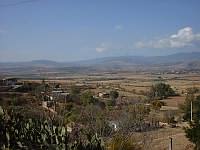 By this time, all the climbing was starting to take its toll. I got off to a
late start. My mechanical failure du jeur - a broken derailleur cable.
Luckily, I am a traveling bike store, and I quickly replaced it. The day was
rough - all climbing or descending. I don't think I used my middle chain ring
all day. By the afternoon, I gave up on the idea of riding 100k, settling
instead on staying near a small town called Yanitlán after 80k. Riding into
Yanitlán, I got my first glimpses of the Oaxacan valley, characterized by sharp
peaks of red soil. It almost glowed in the late afternoon sun. In town was a
huge cathedral, built in the 1500's. I spent the morning photographing, then
began my push to Oaxaca. I had hoped to make it all the way that day, but
after coming up 20k short the day before, I wasn't counting on it. There were
two roads to Oaxaca - one was the same road I had been taking; one lane in
each direction, lots of hills, and no shoulder to speak of. The other was the
"carretera cuota" or pay highway. The latter was shorter and reported to be
flatter with a large shoulder. All proved to be true. THe road was a dream -
15 ft. shoulder, great pavement, no topes, lots of downhill, and no traffic.
The only drawback was the no biking signs every km. It was hard to comprehend;
in a country where a dozen people ride will ride in the back of a pickup, where
everyone drives without lights until well past dark, it was considered unsafe
for bikes to ride on the safest road in Mexico.
By this time, all the climbing was starting to take its toll. I got off to a
late start. My mechanical failure du jeur - a broken derailleur cable.
Luckily, I am a traveling bike store, and I quickly replaced it. The day was
rough - all climbing or descending. I don't think I used my middle chain ring
all day. By the afternoon, I gave up on the idea of riding 100k, settling
instead on staying near a small town called Yanitlán after 80k. Riding into
Yanitlán, I got my first glimpses of the Oaxacan valley, characterized by sharp
peaks of red soil. It almost glowed in the late afternoon sun. In town was a
huge cathedral, built in the 1500's. I spent the morning photographing, then
began my push to Oaxaca. I had hoped to make it all the way that day, but
after coming up 20k short the day before, I wasn't counting on it. There were
two roads to Oaxaca - one was the same road I had been taking; one lane in
each direction, lots of hills, and no shoulder to speak of. The other was the
"carretera cuota" or pay highway. The latter was shorter and reported to be
flatter with a large shoulder. All proved to be true. THe road was a dream -
15 ft. shoulder, great pavement, no topes, lots of downhill, and no traffic.
The only drawback was the no biking signs every km. It was hard to comprehend;
in a country where a dozen people ride will ride in the back of a pickup, where
everyone drives without lights until well past dark, it was considered unsafe
for bikes to ride on the safest road in Mexico.
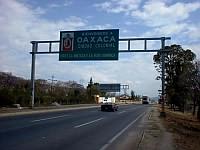 I ignored the signs, as did the police, the highway workers, and the toll booth
attendants. I would just wave and say "Buenos dias" and keep on riding. The
other disadvantage was that there was absolutely nothing enroute - no food, no
water, nothing. Luckily it wasn't too hot, and I managed to survive on two
liters of water. I made record time, and not only made it to Oaxaca, but I
made it by 3pm. My first big haul was over: 7 days, 613km, four broken
spokes, two flats, and a broken derailleur cable. It was time to rest.
I ignored the signs, as did the police, the highway workers, and the toll booth
attendants. I would just wave and say "Buenos dias" and keep on riding. The
other disadvantage was that there was absolutely nothing enroute - no food, no
water, nothing. Luckily it wasn't too hot, and I managed to survive on two
liters of water. I made record time, and not only made it to Oaxaca, but I
made it by 3pm. My first big haul was over: 7 days, 613km, four broken
spokes, two flats, and a broken derailleur cable. It was time to rest.

